Maximizing Lucerne (Medicago sativa) Pasture Intake of Dairy Cows: 1-the Effect of Pre-Grazing Pasture Height and Mixed Ration Level
Abstract
Simple Summary
Abstract
1. Introduction
2. Materials and Methods
2.1. Experimental Design
2.2. Pasture Allocation and Nutritive Value
2.3. Defoliation Intensity and Pasture Intake
2.4. Milk Production
2.5. Statistical Analysis
3. Results
3.1. Defoliation Intensity and Pasture Structure
3.2. Dry Matter Intake and Diet Quality
3.3. Milk Production
4. Discussion
5. Conclusions
Author Contributions
Funding
Acknowledgments
Conflicts of Interest
References
- Chapman, D.; Dassanayake, K.; Hill, J.; Cullen, B.; Lane, N. Forage-based dairying in a water-limited future: Use of models to investigate farming system adaptation in southern Australia. J. Dairy Sci. 2012, 95, 4153–4175. [Google Scholar] [CrossRef] [PubMed]
- Wales, W.J.; Kolver, E.S. Challenges of feeding dairy cows in Australia and New Zealand. Anim. Prod. Sci. 2017, 57, 1366. [Google Scholar] [CrossRef]
- Barber, D.G.; Auldist, M.J.; Anstis, A.R.; Ho, C.K.M. Defining the key attributes of resilience in mixed ration dairy systems. Anim. Prod. Sci. 2020, 60, 17. [Google Scholar] [CrossRef]
- Eastridge, M. Major Advances in Applied Dairy Cattle Nutrition. J. Dairy Sci. 2006, 89, 1311–1323. [Google Scholar] [CrossRef]
- Kolver, E.; Muller, L. Performance and Nutrient Intake of High Producing Holstein Cows Consuming Pasture or a Total Mixed Ration. J. Dairy Sci. 1998, 81, 1403–1411. [Google Scholar] [CrossRef]
- Mezzalira, J.C.; Carvalho, P.; Fonseca, L.; Bremm, C.; Cangiano, C.; Gonda, H.L.; Laca, E.A. Behavioural mechanisms of intake rate by heifers grazing swards of contrasting structures. Appl. Anim. Behav. Sci. 2014, 153, 1–9. [Google Scholar] [CrossRef]
- Pembleton, K.G.; Sathish, P. Giving drought the cold shoulder: A relationship between drought tolerance and fall dormancy in an agriculturally important crop. AoB Plants 2014, 6, 6. [Google Scholar] [CrossRef]
- Ison, K.A.D.; Barber, D.G.; Benvenutti, M.A.; Kleinitz, N.; Mayer, D.; Poppi, D.P. Defoliation dynamics, pasture intake and milk production of dairy cows grazing lucerne pastures in a partial mixed-ration system. Anim. Prod. Sci. 2020, 60, 175. [Google Scholar] [CrossRef]
- Benvenutti, M.A.; Pavetti, D.R.; Poppi, D.P.; Mayer, D.; Gordon, I.J. Ingestive behaviour and forage intake responses of young and mature steers to the vertical differentiation of sugarcane in pen and grazing studies. J. Agric. Sci. 2017, 155, 1677–1688. [Google Scholar] [CrossRef][Green Version]
- Benvenutti, M.; Barber, D.; Ison, K.; Mayer, D.; Yanmeng, L.; Findsen, C. The influence of plant structure on pasture utilisation by dairy cows grazing lucerne (Medicago sativa). In Proceedings of the Australian Society of Animal Production, Wagga Wagga, Australia, 2–4 July 2018. [Google Scholar]
- Fonseca, L.; Carvalho, P.; Mezzalira, J.C.; Bremm, C.; Galli, J.R.; Gregorini, P. Effect of sward surface height and level of herbage depletion on bite features of cattle grazing Sorghum bicolor swards1. J. Anim. Sci. 2013, 91, 4357–4365. [Google Scholar] [CrossRef]
- Kalu, B.A.; Fick, G.W. Quantifying Morphological Development of Alfalfa for Studies of Herbage Quality 1. Crop. Sci. 1981, 21, 267–271. [Google Scholar] [CrossRef]
- Flores, E.R.; Laca, E.; Griggs, T.C.; Demment, M.W. Sward Height and Vertical Morphological Differentiation Determine Cattle Bite Dimensions. Agron. J. 1907, 85, 527–532. [Google Scholar] [CrossRef]
- Auldist, M.J.; Wright, M.M.; Marett, L.C.; Jacobs, J.; Wales, W. Effects of pasture allowance on milk production of dairy cows offered increasing amounts of partial mixed rations in spring. Anim. Prod. Sci. 2017, 57, 1305. [Google Scholar] [CrossRef]
- Benvenutti, M.A.; Pavetti, D.R.; Poppi, D.P.; Gordon, I.J.; Cangiano, C.A. Defoliation patterns and their implications for the management of vegetative tropical pastures to control intake and diet quality by cattle. Grass Forage Sci. 2015, 71, 424–436. [Google Scholar] [CrossRef]
- Hames, B.; Scarlata, C.; Sluiter, A. Determination of Protein Content in Biomass; National Renewable Energy Laboratory: Golden, CO, USA, 2008; pp. 1–5.
- Van Soest, P.; Robertson, J.; Lewis, B. Methods for Dietary Fiber, Neutral Detergent Fiber, and Nonstarch Polysaccharides in Relation to Animal Nutrition. J. Dairy Sci. 1991, 74, 3583–3597. [Google Scholar] [CrossRef]
- Hall, M.B.; Hoover, W.H.; Jennings, J.P.; Webster, T.K.M. A method for partitioning neutral detergent-soluble carbohydrates. J. Sci. Food Agric. 1999, 79, 2079–2086. [Google Scholar] [CrossRef]
- National Research Council. Nutrient Requirements of Dairy Cattle; The National Academies Press: Washington, DC, USA, 2001. [Google Scholar]
- Tyrrell, H.; Reid, J. Prediction of the energy value of cow’s milk. J. Dairy Sci. 1965, 48, 1215–1223. [Google Scholar] [CrossRef]
- Anstis, A.; Barber, D.; Callow, M.; Matthews, M.; Gorman, J.; Fitzgerald, J. An Assessment of Forage Quality and Quantity, Pasture Utilisation and Feed Efficiency on Sub-Tropical Dairy Farms; Queensland Department of Agriculture and Fisheries: Gatton, Austrilia, 2011. [Google Scholar]
- Cangiano, C.A.; Galli, J.R.; Pece, M.A.; Dichio, L.; Rozsypalek, S.H. Effect of liveweight and pasture height on cattle bite dimensions during progressive defoliation. Aust. J. Agric. Res. 2002, 53, 541. [Google Scholar] [CrossRef]
- Laca, E.A.; Ungar, E.D.; Seligman, N.; Demment, M.W. Effects of sward height and bulk density on bite dimensions of cattle grazing homogeneous swards. Grass Forage Sci. 1992, 47, 91–102. [Google Scholar] [CrossRef]
- Benvenutti, M.A.; Gordon, I.J.; Poppi, D.P.; Crowther, R.; Spinks, W.; Moreno, F.C. The horizontal barrier effect of stems on the foraging behaviour of cattle grazing five tropical grasses. Livest. Sci. 2009, 126, 229–238. [Google Scholar] [CrossRef]
- Arnold, G. Some principles in the investigation of selective grazing. Proc. Aust. Soc. Anim. Prod. 1964, 5, 258–271. [Google Scholar]
- Hodgson, J. The control of herbage intake in the grazing ruminant. In Proceedings of the Nutrition Society; CABI Publishing: Wallingford, UK, 1985; Volume 44, pp. 339–346. [Google Scholar]
- Dougherty, C.T.; Smith, E.M.; Bradley, N.W.; Forbes, T.D.A.; Cornelius, P.L.; Lauriault, L.M.; Arnold, C.D. Ingestive behaviour of beef cattle grazing alfalfa (Medicago sativa L.). Grass Forage Sci. 1988, 43, 121–130. [Google Scholar] [CrossRef]
- Ison, K.A.D.; Benvenutti, M.A.; Mayer, D.G.; Quigley, S.; Barber, D.G. 2—Maximizing lucerne (Medicago sativa) pasture intake of dairy cows: 2—The effect of post grazing pasture height and mixed ration level. Animals 2020. submitted for publication. [Google Scholar]
- Bargo, F.; Muller, L.; Delahoy, J.; Cassidy, T. Milk Response to Concentrate Supplementation of High Producing Dairy Cows Grazing at Two Pasture Allowances. J. Dairy Sci. 2002, 85, 1777–1792. [Google Scholar] [CrossRef]
- Golder, H.; Denman, S.; McSweeney, C.; Wales, W.; Auldist, M.; Wright, M.; Marett, L.; Greenwood, J.; Hannah, M.; Celi, P.; et al. Effects of partial mixed rations and supplement amounts on milk production and composition, ruminal fermentation, bacterial communities, and ruminal acidosis. J. Dairy Sci. 2014, 97, 5763–5785. [Google Scholar] [CrossRef] [PubMed]
- Walker, G.; Stockdale, C.; Wales, W.; Doyle, P.T.; Dellow, D.W. Effect of level of grain supplementation on milk production responses of dairy cows in mid—Late lactation when grazing irrigated pastures high in paspalum (Paspalum dilatatum Poir.). Aust. J. Exp. Agric. 2001, 41, 1–11. [Google Scholar] [CrossRef]
- Stockdale, C.; Callaghan, A.; Trigg, T. Feeding high energy supplements to pasture-fed dairy cows. Effects of stage of lactation and level of supplement. Aust. J. Agric. Res. 1987, 38, 927–940. [Google Scholar] [CrossRef]
- Lock, A.L.; Overton, T.R.; Harvatine, K.J.; Giesy, J.; Bauman, D.E. Milk fat depression: Impact of dietary components and their interaction during rumen fermentation. In Proceedings of the Cornell Nutrition Conference, East Syracuse, NY, USA, 16–18 October 2018; Cornell University: Ithaca, NY, USA, 2018; pp. 75–85. [Google Scholar]
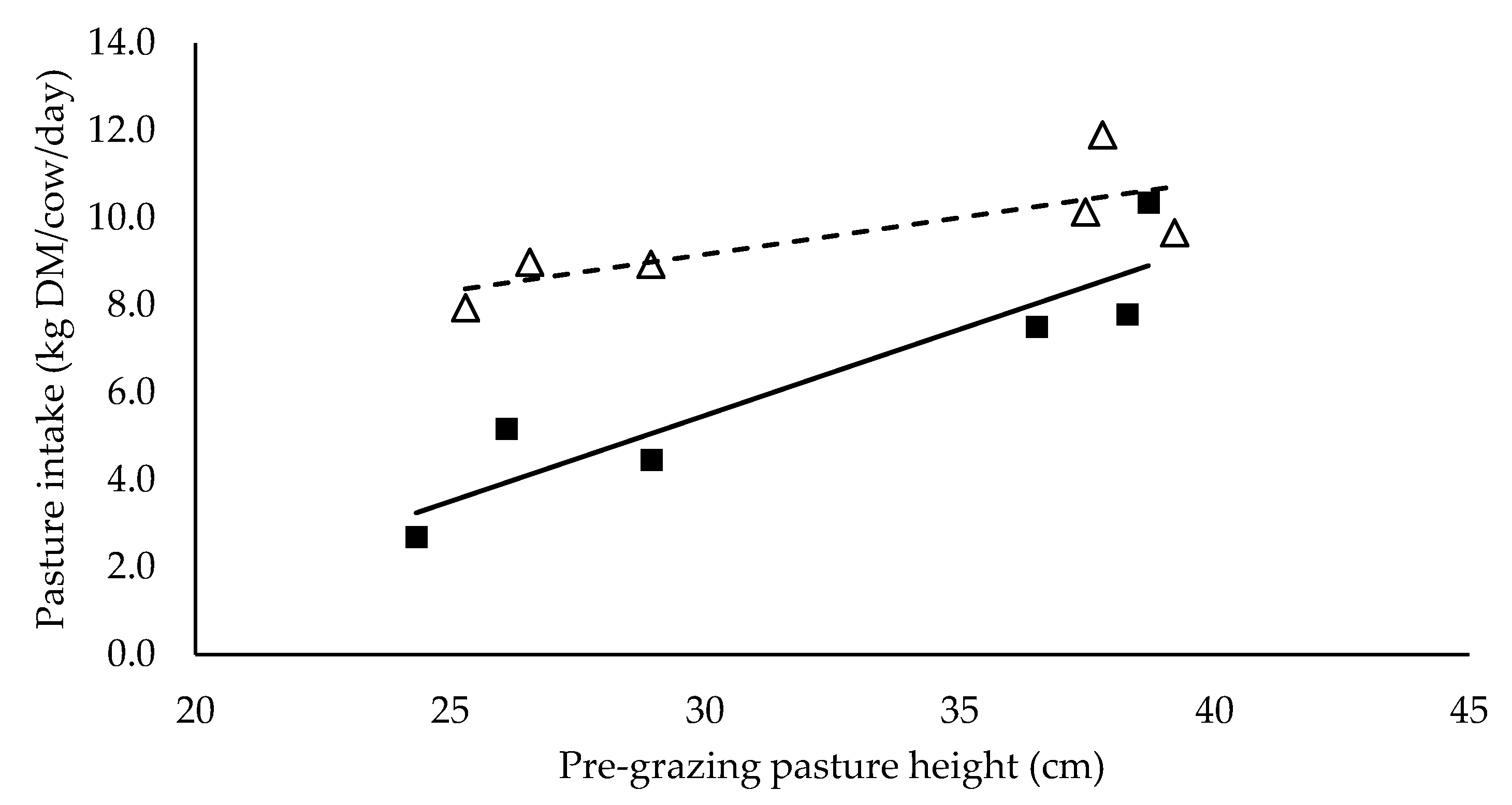
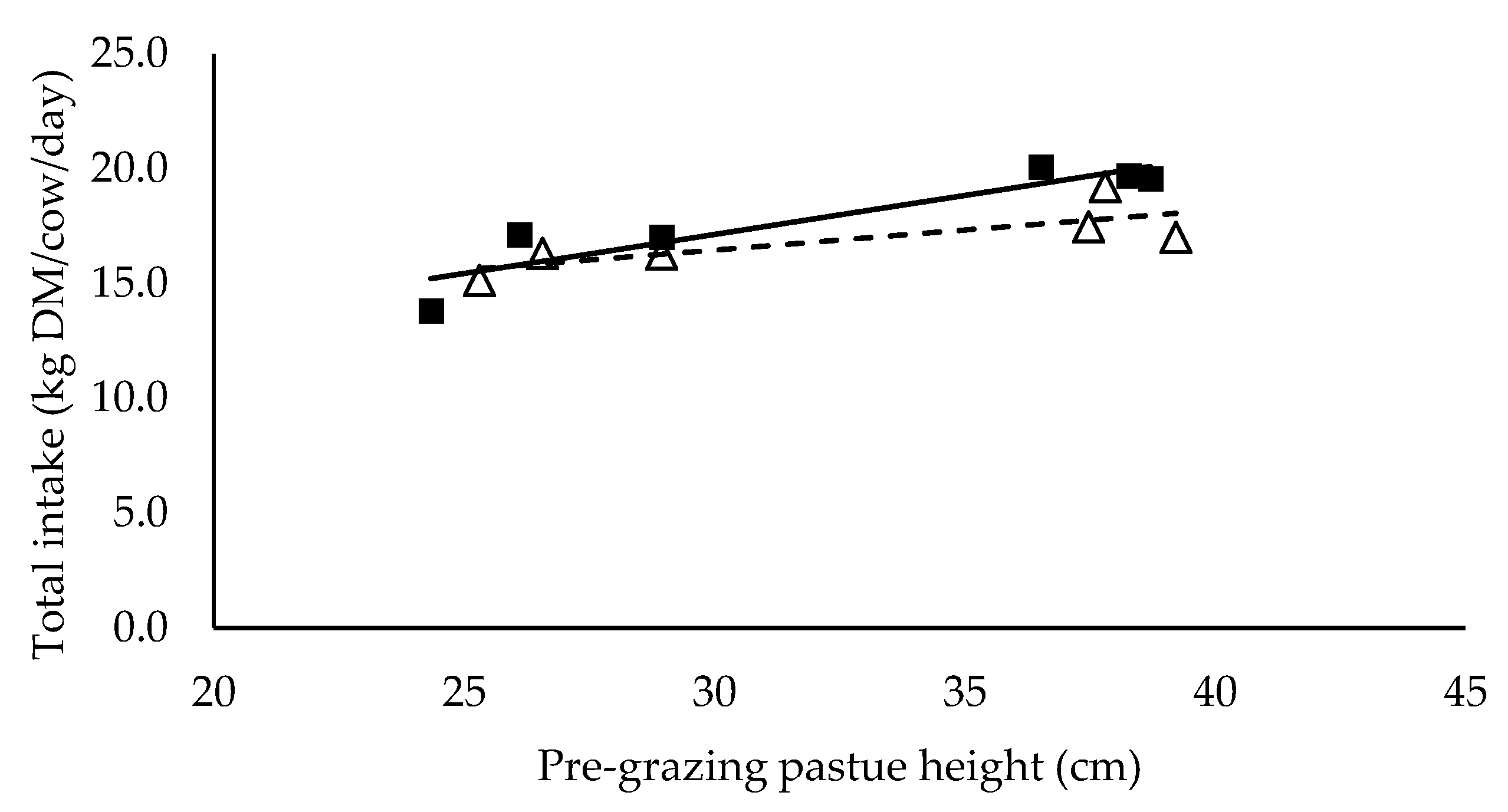
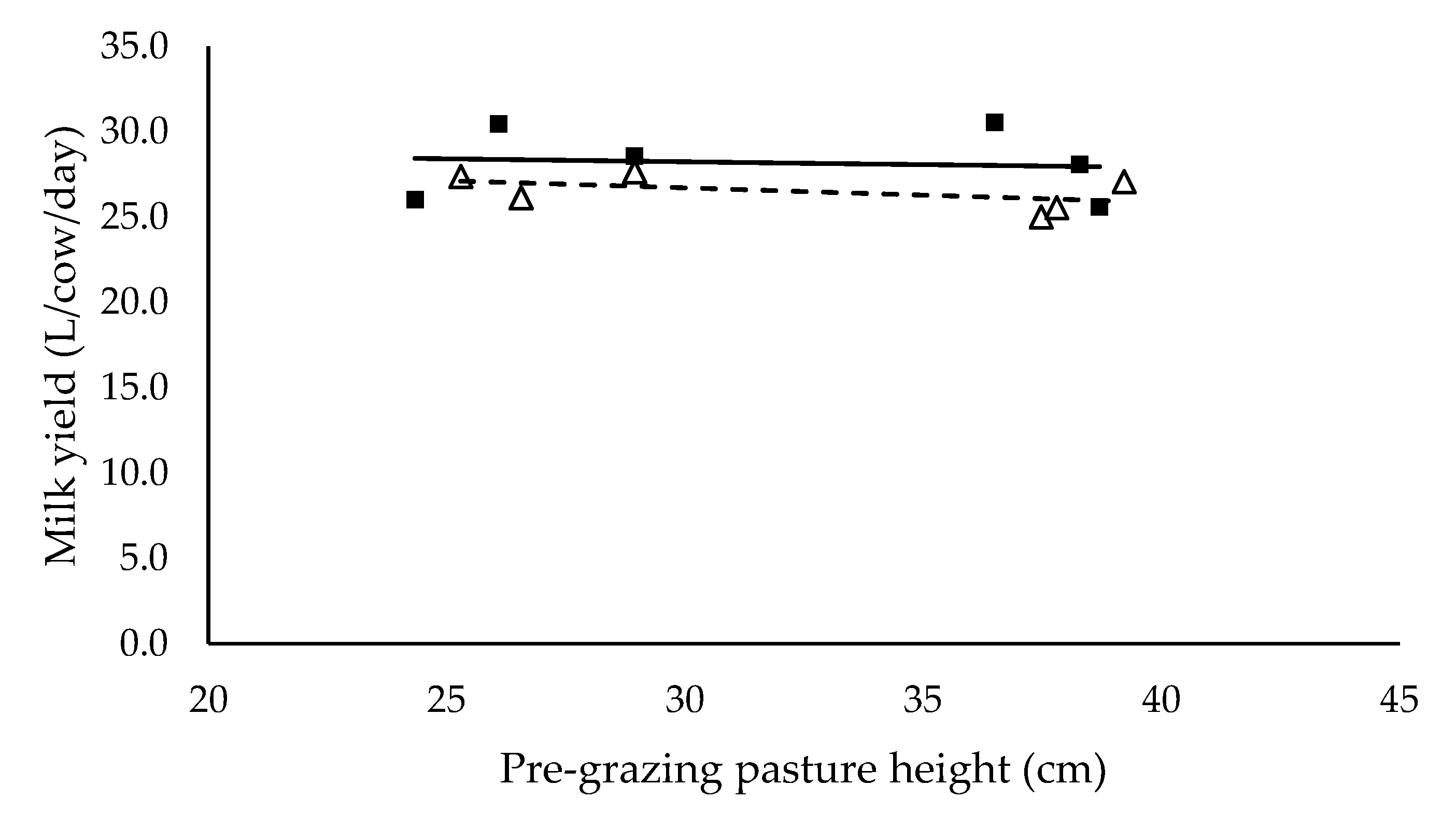
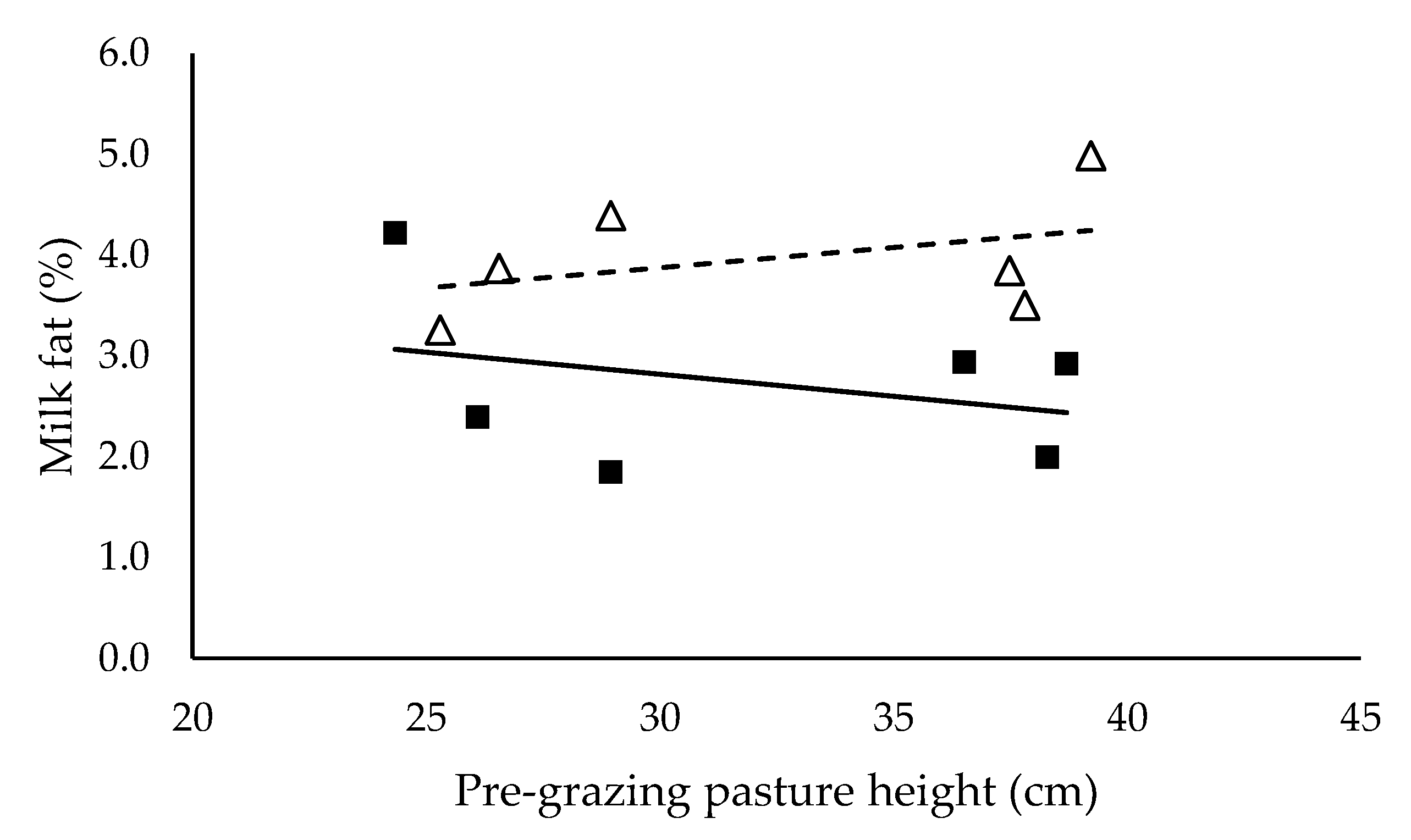
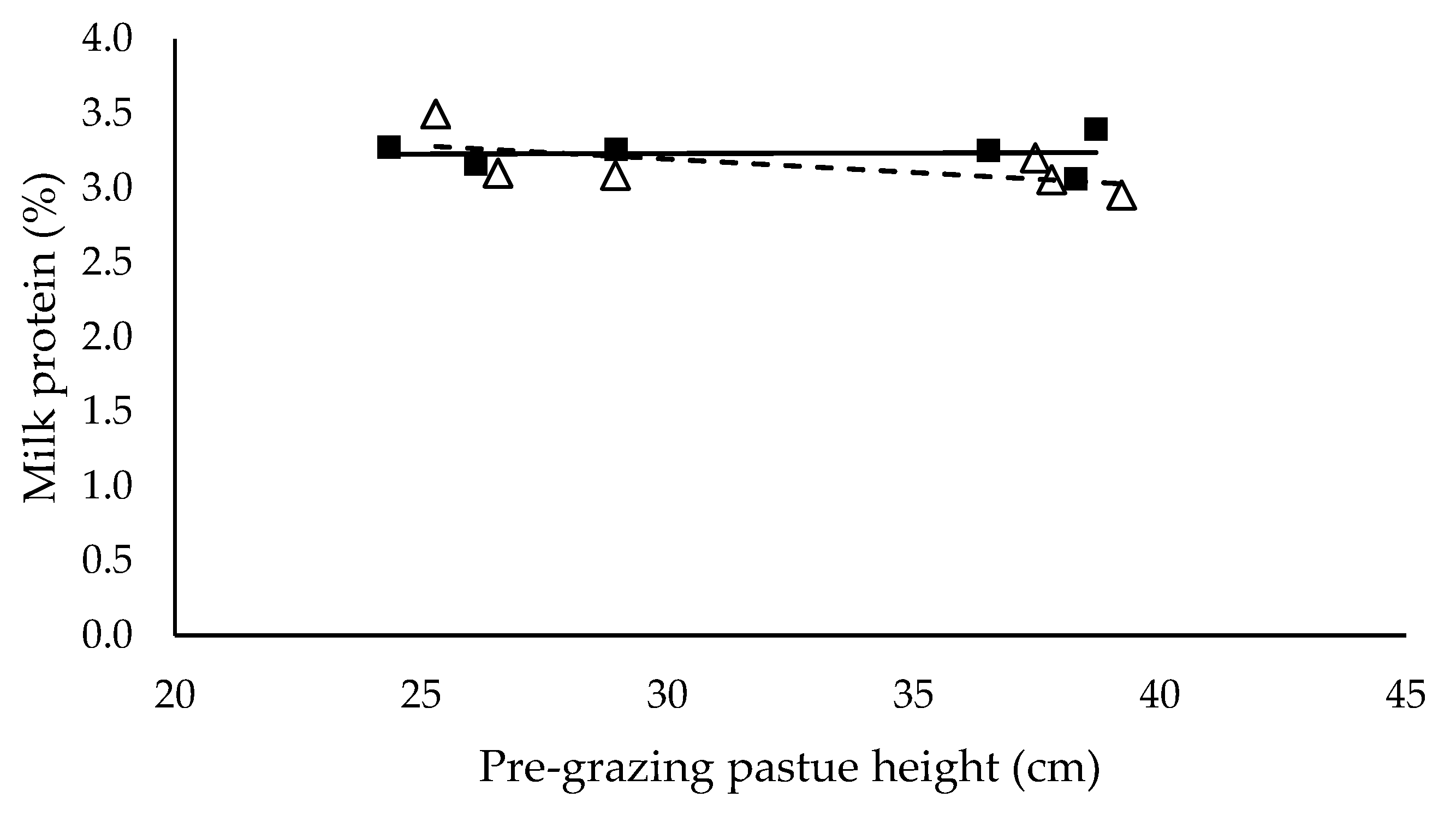
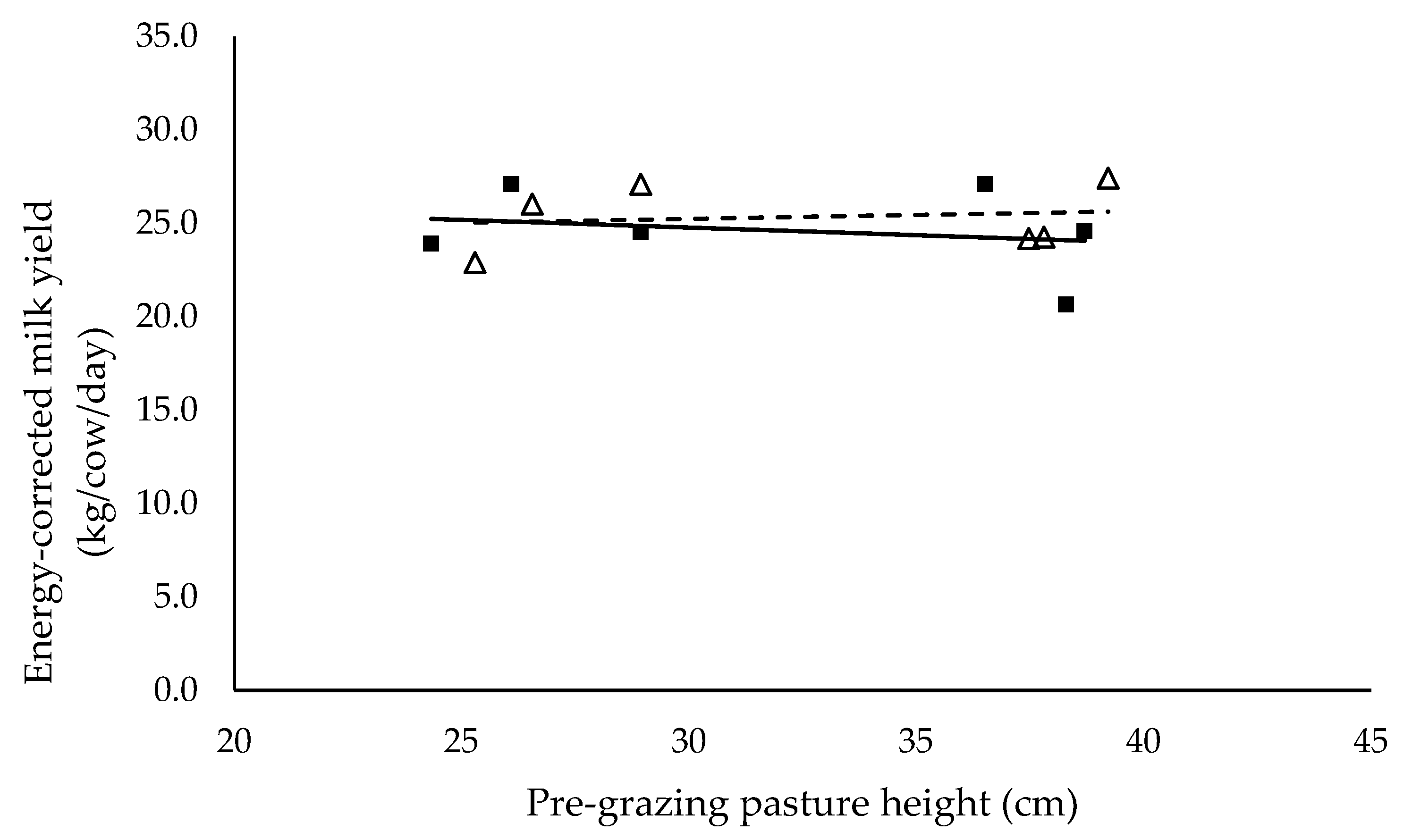
| Ingredient (kg DM/cow/day) | High | Low |
|---|---|---|
| Corn silage | 6.71 | 4.15 |
| Barley grain | 3.15 | 1.22 |
| Wheat grain | 1.89 | 0.75 |
| Canola meal | 0.9 | 0 |
| Lucerne hay | 0.9 | 0.45 |
| Mineral mix | 0.44 | 0.44 |
| Total mixed ration | 13.99 | 7.01 |
| Target pasture intake | 7.0 | 14.0 |
| Target total intake | 21.0 | 21.0 |
| Mixed Ration Level | Target Pre-Grazing Pasture Height (cm) | Actual Pre-Grazing Pasture Height (cm) | Pasture Offered (kg DM/ha) | Pasture Offered (kg DM/cow/day) | Grazing Depth (cm) | Average Area Grazed (%) |
|---|---|---|---|---|---|---|
| High | 25 | 24.34 | 956.21 | 15.68 | 14.02 | 37.41 |
| High | 25 | 26.10 | 1047.34 | 17.07 | 11.71 | 48.27 |
| High | 35 | 28.95 | 1034.89 | 17.53 | 12.27 | 51.29 |
| High | 50 | 36.51 | 1492.56 | 26.56 | 16.57 | 49.67 |
| High | 50 | 38.29 | 1579.60 | 28.61 | 12.44 | 77.35 |
| High | 35 | 38.70 | 1488.57 | 26.64 | 14.13 | 87.47 |
| Low | 25 | 25.30 | 1007.36 | 34.60 | 10.15 | 48.85 |
| Low | 25 | 26.56 | 1071.19 | 38.29 | 12.73 | 38.10 |
| Low | 35 | 28.94 | 1034.58 | 36.11 | 11.33 | 54.50 |
| Low | 50 | 37.47 | 1539.45 | 55.51 | 10.51 | 53.00 |
| Low | 50 | 37.80 | 1555.71 | 54.54 | 11.68 | 60.05 |
| Low | 35 | 39.22 | 1512.44 | 53.23 | 13.75 | 51.49 |
| R2 | 0.98 | 0.38 | 0.67 | |||
| PMR effect + | *** | |||||
| Slope (low) | 1.54 *** | 0.071 | 0.71 | |||
| Slope (high) | 0.89 *** | 0.105 | 2.49 ** |
| Mixed Ration Level | Pre-Grazing Pasture Height | Metabolisable Energy | Crude Protein | Neutral Detergent Fibre | Acid Detergent Fibre | Lignin | Starch | Sugars |
|---|---|---|---|---|---|---|---|---|
| High | 24.34 | 33.0 | 34.83 | 16.74 | 16.20 | 5.66 | 5.86 | 8.78 |
| High | 26.10 | 62.9 | 34.08 | 17.77 | 17.05 | 5.73 | 5.40 | 8.65 |
| High | 28.95 | 54.6 | 33.95 | 17.66 | 16.78 | 5.58 | 5.49 | 8.66 |
| High | 36.51 | 92.7 | 32.85 | 18.62 | 17.20 | 5.36 | 5.20 | 8.54 |
| High | 38.29 | 96.6 | 32.72 | 18.64 | 17.11 | 5.28 | 5.25 | 8.53 |
| High | 38.70 | 127.0 | 31.97 | 19.81 | 18.16 | 5.43 | 4.82 | 8.38 |
| Low | 25.30 | 97.2 | 34.46 | 17.24 | 16.60 | 5.69 | 5.63 | 8.72 |
| Low | 26.56 | 110.2 | 34.32 | 17.34 | 16.62 | 5.65 | 5.60 | 8.70 |
| Low | 28.94 | 109.7 | 33.92 | 17.71 | 16.82 | 5.59 | 5.47 | 8.66 |
| Low | 37.47 | 126.7 | 33.36 | 17.69 | 16.29 | 5.18 | 5.60 | 8.66 |
| Low | 37.80 | 148.6 | 33.16 | 17.99 | 16.54 | 5.21 | 5.49 | 8.62 |
| Low | 39.22 | 121.3 | 33.25 | 17.68 | 16.17 | 5.10 | 5.61 | 8.66 |
| R2 | 0.88 | 0.94 | 0.84 | 0.71 | 0.95 | 0.76 | 0.84 | |
| Mixed ration effect + | * | * | * | * | * | * | * | |
| Slope (low) | 0.0225 *** | −0.088 *** | 0.035 | −0.0283 | −0.0420 *** | −0.0013 | −0.0046 | |
| Slope (high) | 0.0080 * | −0.159 *** | 0.149 *** | 0.0764 * | −0.0256 *** | −0.0457 ** | −0.0196 *** |
| Mixed Ration Level | Pre-grazing Pasture Height | Mixed Ration a | Pasture a | Metabolisable Energy | Crude Protein | Neutral Detergent Fibre | Acid Detergent Fibre | Lignin | Starch | Sugars |
|---|---|---|---|---|---|---|---|---|---|---|
| High | 24.34 | 80.6 | 19.4 | 139.90 | 19.87 | 21.75 | 15.53 | 3.49 | 28.88 | 3.58 |
| High | 26.10 | 70.2 | 29.8 | 182.23 | 21.67 | 21.28 | 15.86 | 3.80 | 25.93 | 4.30 |
| High | 28.95 | 74.8 | 25.2 | 170.94 | 20.78 | 21.52 | 15.76 | 3.61 | 27.26 | 4.00 |
| High | 36.51 | 63.1 | 36.9 | 211.47 | 22.47 | 21.26 | 16.09 | 3.86 | 23.78 | 4.69 |
| High | 38.29 | 60.4 | 39.6 | 212.99 | 22.84 | 21.12 | 16.02 | 3.89 | 23.03 | 4.84 |
| High | 38.70 | 47.5 | 52.5 | 217.77 | 24.56 | 21.25 | 16.83 | 4.28 | 18.97 | 5.55 |
| Low | 25.30 | 49.3 | 50.7 | 151.98 | 24.38 | 19.93 | 16.27 | 4.31 | 20.23 | 5.60 |
| Low | 26.56 | 45.9 | 54.1 | 178.49 | 24.99 | 19.85 | 16.24 | 4.37 | 19.18 | 5.79 |
| Low | 28.94 | 47.3 | 52.7 | 152.13 | 24.45 | 20.13 | 16.53 | 4.32 | 19.46 | 5.66 |
| Low | 37.47 | 42.8 | 57.2 | 191.22 | 25.09 | 19.86 | 16.13 | 4.21 | 18.23 | 5.95 |
| Low | 37.80 | 38.7 | 61.3 | 209.86 | 25.79 | 19.67 | 16.20 | 4.31 | 17.07 | 6.18 |
| Low | 39.22 | 44.1 | 55.9 | 184.63 | 24.77 | 19.95 | 16.03 | 4.13 | 18.61 | 5.87 |
| R2 | 0.92 | 0.92 | 0.78 | 0.90 | 0.97 | 0.63 | 0.85 | 0.91 | 0.93 | |
| Mixed ration effect + | *** | *** | *** | *** | * | *** | *** | *** | ||
| Slope (low) | −0.0048 | 0.0048 | 2.81 * | 0.00048 | −0.00009 | −0.00017 | −0.00011 | −0.0014 | 0.00026 | |
| Slope (high) | −0.0161 ** | 0.0161 ** | 4.41 ** | 0.00224 ** | −0.00027 * | 0.00054 * | 0.00034 ** | −0.0048 ** | 0.00096 *** |
| Y Variate | R2 | High Intercept | High Slope | Low Intercept | Low Slope |
|---|---|---|---|---|---|
| Pasture intake (kg DM/cow/day) | 0.89 | −6.35 | 0.394 *** | 4.12 | 0.168 * |
| Total intake (kg DM/cow/day) | 0.80 | 6.93 | 0.340 ** | 11.28 | 0.173 * |
| Milk yield (L/cow/day) | 0.69 | 29.5 | 0.0287 | 30.4 | −0.0296 |
| Energy-corrected milk yield (kg/cow/day) | 0.53 | 1.74 | 0.0131 | 3.59 | −0.0005 |
| Milk fat (%) | 0.25 | 2.92 | 0.0042 | 2.88 | 0.0047 * |
| Milk protein (%) | 0.46 | 20.9 | 0.718 | 28.4 | −0.0024 |
© 2020 by the authors. Licensee MDPI, Basel, Switzerland. This article is an open access article distributed under the terms and conditions of the Creative Commons Attribution (CC BY) license (http://creativecommons.org/licenses/by/4.0/).
Share and Cite
Ison, K.A.D.; Benvenutti, M.A.; Mayer, D.G.; Quigley, S.; Barber, D.G. Maximizing Lucerne (Medicago sativa) Pasture Intake of Dairy Cows: 1-the Effect of Pre-Grazing Pasture Height and Mixed Ration Level. Animals 2020, 10, 860. https://doi.org/10.3390/ani10050860
Ison KAD, Benvenutti MA, Mayer DG, Quigley S, Barber DG. Maximizing Lucerne (Medicago sativa) Pasture Intake of Dairy Cows: 1-the Effect of Pre-Grazing Pasture Height and Mixed Ration Level. Animals. 2020; 10(5):860. https://doi.org/10.3390/ani10050860
Chicago/Turabian StyleIson, Kieran A. D., Marcelo A. Benvenutti, David G. Mayer, Simon Quigley, and David G. Barber. 2020. "Maximizing Lucerne (Medicago sativa) Pasture Intake of Dairy Cows: 1-the Effect of Pre-Grazing Pasture Height and Mixed Ration Level" Animals 10, no. 5: 860. https://doi.org/10.3390/ani10050860
APA StyleIson, K. A. D., Benvenutti, M. A., Mayer, D. G., Quigley, S., & Barber, D. G. (2020). Maximizing Lucerne (Medicago sativa) Pasture Intake of Dairy Cows: 1-the Effect of Pre-Grazing Pasture Height and Mixed Ration Level. Animals, 10(5), 860. https://doi.org/10.3390/ani10050860





